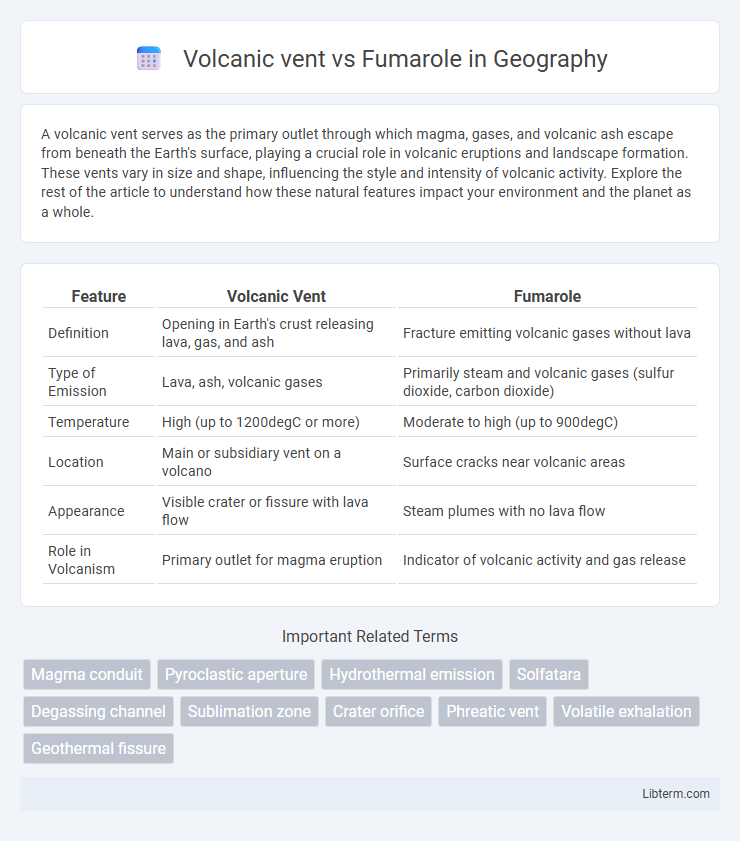A volcanic vent serves as the primary outlet through which magma, gases, and volcanic ash escape from beneath the Earth's surface, playing a crucial role in volcanic eruptions and landscape formation. These vents vary in size and shape, influencing the style and intensity of volcanic activity. Explore the rest of the article to understand how these natural features impact your environment and the planet as a whole.
Table of Comparison
| Feature | Volcanic Vent | Fumarole |
|---|---|---|
| Definition | Opening in Earth's crust releasing lava, gas, and ash | Fracture emitting volcanic gases without lava |
| Type of Emission | Lava, ash, volcanic gases | Primarily steam and volcanic gases (sulfur dioxide, carbon dioxide) |
| Temperature | High (up to 1200degC or more) | Moderate to high (up to 900degC) |
| Location | Main or subsidiary vent on a volcano | Surface cracks near volcanic areas |
| Appearance | Visible crater or fissure with lava flow | Steam plumes with no lava flow |
| Role in Volcanism | Primary outlet for magma eruption | Indicator of volcanic activity and gas release |
Introduction to Volcanic Vents and Fumaroles
Volcanic vents are openings in the Earth's crust where magma, gases, and volcanic ash escape during an eruption, playing a crucial role in shaping volcanic landscapes. Fumaroles are specific types of vents that emit steam and volcanic gases such as sulfur dioxide and carbon dioxide without erupting lava, often forming around active or dormant volcanoes. Understanding these features is essential for monitoring volcanic activity and assessing geological hazards.
Defining Volcanic Vents
Volcanic vents are openings on the Earth's surface through which magma, gases, and volcanic ash escape during an eruption, forming mountains or lava flows. These vents are primary conduits connecting the magma chamber beneath the surface to the atmosphere, shaping volcanic landscapes. In contrast, fumaroles are smaller fissures emitting only volcanic gases without lava, often found near volcanic vents as residual features of volcanic activity.
Understanding Fumaroles
Fumaroles are openings near volcanic vents that emit steam and volcanic gases such as sulfur dioxide, carbon dioxide, and hydrogen sulfide. Unlike volcanic vents, which primarily release molten lava and ash, fumaroles primarily release vapor and gases due to the interaction of groundwater with hot magma beneath the surface. Understanding fumaroles involves studying their gas emissions to monitor volcanic activity and assess potential hazards associated with gas release.
Key Differences Between Volcanic Vents and Fumaroles
Volcanic vents are openings on the Earth's surface where magma, gases, and volcanic ash erupt, forming new landforms and releasing molten lava. In contrast, fumaroles are smaller cracks or openings that emit steam and volcanic gases without expelling lava, often found near volcanic vents or within geothermal areas. The key difference lies in their activity: volcanic vents actively release magma during eruptions, while fumaroles primarily vent steam and gases, indicating ongoing volcanic or geothermal activity without lava flow.
Formation Processes of Volcanic Vents
Volcanic vents form through the movement of magma from beneath the Earth's crust, where pressure buildup causes fractures in the rock, allowing molten lava to erupt onto the surface. These vents serve as primary pathways for magma, gases, and volcanic ash to escape during volcanic activity, shaping the landscape over time. Unlike fumaroles, which emit primarily steam and volcanic gases from solidified lava, volcanic vents are direct openings connected to active magma chambers.
How Fumaroles Develop
Fumaroles develop when groundwater or surface water interacts with hot magma or volcanic gases beneath the Earth's surface, causing steam and volcanic gases such as sulfur dioxide and carbon dioxide to escape through cracks and fissures in volcanic rocks. These openings form in areas where volcanic activity creates sufficient heat to vaporize water, leading to continuous or intermittent gas emissions. Unlike volcanic vents, which primarily release lava or pyroclastic material, fumaroles mainly emit gases and represent key indicators of subterranean volcanic activity.
Typical Locations of Volcanic Vents vs Fumaroles
Volcanic vents are typically located at the summit or flanks of active volcanoes, where magma reaches the Earth's surface, forming craters or fissures. Fumaroles are commonly found in volcanic regions but often appear around volcanic vents, within geothermal fields, or on the edges of lava flows where volcanic gases escape through fractures. Both features are indicators of volcanic activity, but fumaroles are more widespread in geothermal areas beyond just the central vent locations.
Environmental Impacts and Hazards
Volcanic vents release molten lava, volcanic gases, and ash, leading to immediate hazards such as lava flows, ashfall, and pyroclastic flows that can devastate ecosystems and air quality. Fumaroles emit mainly steam and volcanic gases like sulfur dioxide and carbon dioxide, which contribute to acid rain, soil acidification, and long-term atmospheric pollution. Both phenomena pose risks to human health through toxic gas exposure, but volcanic vents typically cause more acute and widespread environmental damage compared to the relatively localized effects of fumaroles.
Scientific Importance in Volcanology
Volcanic vents serve as primary pathways for magma, gases, and molten rock to escape from the Earth's interior, providing crucial data on magma composition and volcanic activity. Fumaroles, emitting primarily steam and volcanic gases like sulfur dioxide and carbon dioxide, offer essential insights into the chemistry of volcanic gases and subsurface geothermal processes. Studying these features enables volcanologists to monitor eruption precursors, assess volcanic hazards, and understand the dynamics of magma movement beneath volcanoes.
Conclusion: Volcanic Vents and Fumaroles Compared
Volcanic vents are primary pathways through which magma reaches the Earth's surface, forming features like craters and lava flows, while fumaroles are openings emitting volcanic gases such as sulfur dioxide and steam without direct lava discharge. Both structures indicate active geothermal processes, but vents are crucial for magma eruption, whereas fumaroles represent gaseous venting primarily after major eruptive events. Understanding the distinction between volcanic vents and fumaroles aids in monitoring volcanic activity and assessing potential eruption hazards.
Volcanic vent Infographic

 libterm.com
libterm.com